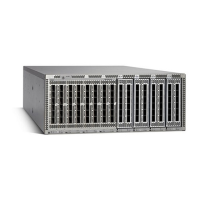Before You Begin
Ensure that STP is configured.
Ensure that you have configured some spanning tree edge ports.
Procedure
PurposeCommand or Action
Enters global configuration mode.switch# configure terminal
Step 1
Enables BPDU Guard by default on all spanning
tree edge ports. By default, global BPDU Guard
is disabled.
switch(config)# spanning-tree port type
edge bpduguard default
Step 2
This example shows how to enable BPDU Guard on all spanning tree edge ports:
switch# configure terminal
switch(config)# spanning-tree port type edge bpduguard default
Enabling BPDU Guard on Specified Interfaces
You can enable BPDU Guard on specified interfaces. Enabling BPDU Guard shuts down the port if it receives
a BPDU.
You can configure BPDU Guard on specified interfaces as follows:
• spanning-tree bpduguard enable—Unconditionally enables BPDU Guard on the interface.
• spanning-tree bpduguard disable—Unconditionally disables BPDU Guard on the interface.
• no spanning-tree bpduguard—Enables BPDU Guard on the interface if it is an operational edge port
and if the spanning-tree port type edge bpduguard default command is configured.
Before You Begin
Ensure that STP is configured.
Procedure
PurposeCommand or Action
Enters global configuration mode.switch# configure terminal
Step 1
Specifies the interface to configure, and enters the interface
configuration mode.
switch(config)# interface type
slot/port
Step 2
If this is a 10G breakout port, the slot/port syntax
is QSFP-module/port.
Note
Cisco Nexus 6000 Series NX-OS Layer 2 Switching Configuration Guide, Release 7.x
101
Configuring STP Extensions
Configuring STP Extensions

